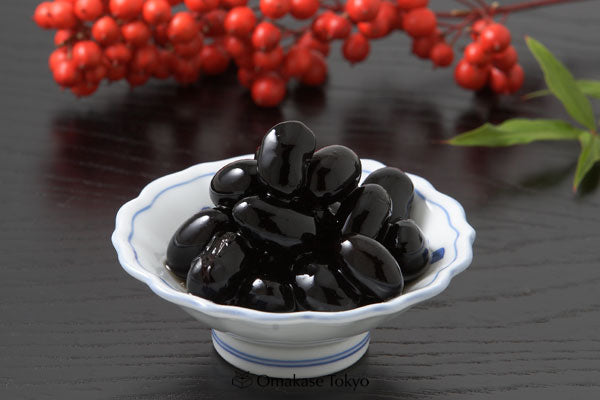Tamba no Kuromame, or Tamba black soybeans, are a highly prized delicacy and agricultural specialty from the Tamba region in Japan, which lies between Kyoto and Hyogo prefectures. Known for their large size, rich flavor, and health benefits, these premium black soybeans are cherished in Japanese cuisine, particularly during celebrations and traditional festivals. Tamba no Kuromame has a unique place in Japanese culture, often associated with good luck, prosperity, and well-being.
What Makes Tamba no Kuromame Special?
Tamba black soybeans are celebrated for their distinct quality, which comes from the region’s ideal farming conditions. The soil in Tamba is rich and fertile, and the climate—marked by warm days and cool nights—contributes to the beans' exceptional size and flavor. These beans are larger than typical black soybeans, have a lustrous, deep-black color, and are known for their dense yet tender texture.
Unlike standard black soybeans, Tamba no Kuromame is not only larger but also sweeter and richer in taste, with a slight nuttiness that adds depth to dishes. The combination of size, taste, and nutritional value has made these beans a sought-after ingredient across Japan.
Culinary Uses of Tamba Black Soybeans
Tamba no Kuromame is versatile and used in both sweet and savory Japanese dishes. Here are some traditional ways these black soybeans are enjoyed:
-
Kuromame Nimame: This is one of the most iconic preparations, especially popular during New Year’s celebrations, or osechi ryori. The beans are simmered in a sweet soy-based sauce until they are tender and glossy. Kuromame nimame is served as a symbol of hard work and health, often placed in an osechi box to bring luck for the coming year.
-
Snack and Sweets: Tamba black soybeans are sometimes lightly salted and roasted for a simple, protein-rich snack. They are also used in traditional Japanese sweets, such as manju (sweet buns filled with bean paste) or as an ingredient in wagashi (Japanese confections), where their natural sweetness complements other ingredients.
-
Salads and Stews: These beans add a hearty element to stews and salads, providing a boost of flavor, fiber, and protein. In modern Japanese cuisine, they are often mixed with grains, vegetables, and other legumes for a wholesome dish.
-
Powdered Kuromame for Tea: Tamba black soybeans are sometimes ground into a fine powder and used in kuromame tea, a caffeine-free, earthy tea rich in antioxidants and believed to promote good health.
Health Benefits of Tamba no Kuromame
Tamba black soybeans are considered a superfood, packed with nutrients. They contain high levels of protein, dietary fiber, and essential minerals, such as iron, calcium, and magnesium. Additionally, they are rich in antioxidants—especially anthocyanins, which are found in their dark pigment and help protect the body against oxidative stress. These beans are also known to support heart health, aid in digestion, and promote overall wellness.
The Cultural Significance of Tamba no Kuromame
In Japanese culture, kuromame has long been associated with good fortune and resilience. During the New Year, eating black beans is believed to bring strength and endurance, symbolizing the wish to work diligently and remain healthy in the year ahead. The traditional New Year dish, kuromame nimame, embodies these values and is one of the most cherished components of osechi ryori.
Tamba no Kuromame in Modern Times
Today, Tamba no Kuromame remains a specialty product that is widely recognized as a high-quality ingredient. These black soybeans can be found in both traditional Japanese markets and high-end specialty stores. They are also sometimes exported, allowing international consumers to experience this unique taste of Japanese culture.
Another Scent from Japan
Tamba no Kuromame, the black soybeans of Tamba, is a true symbol of Japanese heritage and craftsmanship. With its distinctive size, taste, and nutritional benefits, Tamba no Kuromame continues to be a beloved ingredient that bridges the past and present. Whether enjoyed as part of a traditional New Year’s celebration or incorporated into modern dishes, these beans remain a culinary treasure and a testament to the rich agricultural history of Japan’s Tamba region.






